Table of Contents:
1. What is ChatGPT
2. How to Use ChatGPT
3. ChatGPT for Acquisition Targets
4. Example: A Search for Software Vendors in Public Transit
5. Challenges Finding Targets with ChatGPT
6. Mapping the Market
7. GalaxyRM – ChatGPT Integration
We were recently asked by a serial acquirer of software businesses how ChatGPT might be used to help them source deals faster. Adding new leads into the relationship management system is an important task for any member of a deal sourcing team however, surfing the internet for company names that meet a specific set of criteria can be a tedious and time consuming task. So we decided we’d test out ChatGPT ourselves to see if it could help us identify potential acquisition targets.
What Is ChatGPT?
Let’s do a brief introduction to ChatGPT before we get into the details of what we tried and the results. ChatGPT is an artificial intelligence chatbot developed by OpenAI, an artificial intelligence research company with a mission to ensure that artificial general intelligence benefits all of humanity. It was trained to respond to a wide array of queries by learning from a data model. The data model is based on the relationships found in huge volumes of data (570 GB of data for the first version of ChatGPT, to be exact) in books, webtext, Wikipedia and other articles on the internet, along with some human training.
Essentially, ChatGPT learned to automatically output responses to pretty much any query you type into its user interface. It can respond with a wide range of outputs, from essays, answers to test questions and stories, to music or computer programming code.
ChatGPT was initially launched as a free prototype in November 2022 and since then, OpenAI has released updated versions to their free service. A premium, paid version of ChatGPT was launched in January 2023 and is available for $42 USD per month. The paid version gives you access to a ChatGPT model that has been trained on more up-to-date data, faster response times, less down time and a few other features. For the purposes of our testing, we used the free version of ChatGPT.
How to Use ChatGPT
It’s very easy to use ChatGPT.
Go to https://openai.com/blog/chatgpt and click ‘Try ChatGPT’. You will be asked to sign-up with an email address, name and a phone number (the phone number is used to authenticate you via text message). After acknowledging that ChatGPT is still a prototype, you’re ready to go. You are automatically taken to the chatbot interface where you are given some examples of how to interact with the chatbot. There you will see an empty text field into which you can type whatever you like.
ChatGPT for Acquisition Targets
Now back to our initial question - can ChatGPT help us source deals (i.e., by helping us find new potential acquisition targets)?
To test this out we started with a target market segment that we’re familiar with so that we could verify the accuracy of the results. We also wanted to test a segment that is niche enough to be a reasonable challenge (i.e. a deal sourcer would have to sift through multiple Google search results pages and visit multiple websites to assemble a good list of vendors in the space). We chose public transit software companies.
A Search for Software Vendors in Public Transit
Our first query (shown in the image below) was “List 10 software vendors in the public transit software market”. Now this isn’t a particularly difficult task for someone who knows this market fairly well but we wanted to start with something easy that we could verify.
Sure enough, within a few seconds ChatGPT produced a list of 10 software vendors in the public transit software market (we verified that the list was correct).
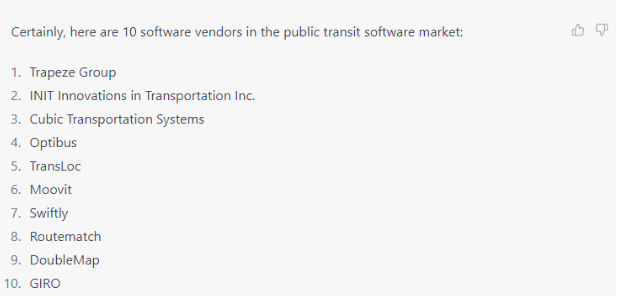
Next, we wanted to add to the list and so we repeated the same query but qualified it by stating that the software vendors cannot be in the previous list. ChatGPT responded by providing a list of ten more vendors that were not in the initial list. Again, all of the new vendors were checked and confirmed to be firmly in the public transit software market.

We repeated this query one more time to add even more companies to our list, as shown below.
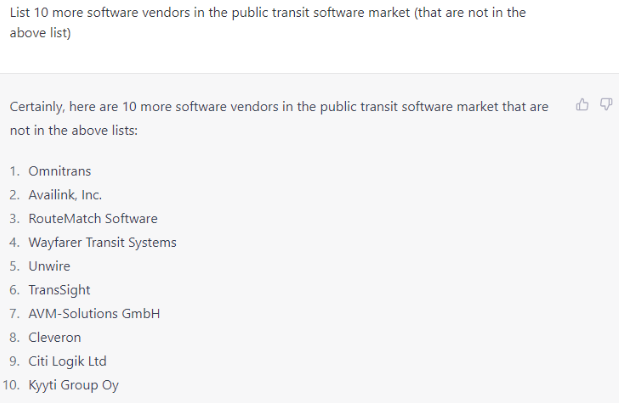
Building a Bigger List
Then we challenged ChatGPT even more by asking it to add 25 more unique vendors to our list of 30. This is where we started to see the quality of the list diminish slightly, although overall it was still a useful list.
You can see in the image below that some of the vendors listed by ChatGPT aren’t actually unique vendors but rather software products offered by a vendor already on the list (i.e. Hastus by GIRO is a software product offered by GIRO, which was already a vendor on our list). As we challenged the chatbot to add more vendors to the list, it sometimes struggled to differentiate between a product and a company.
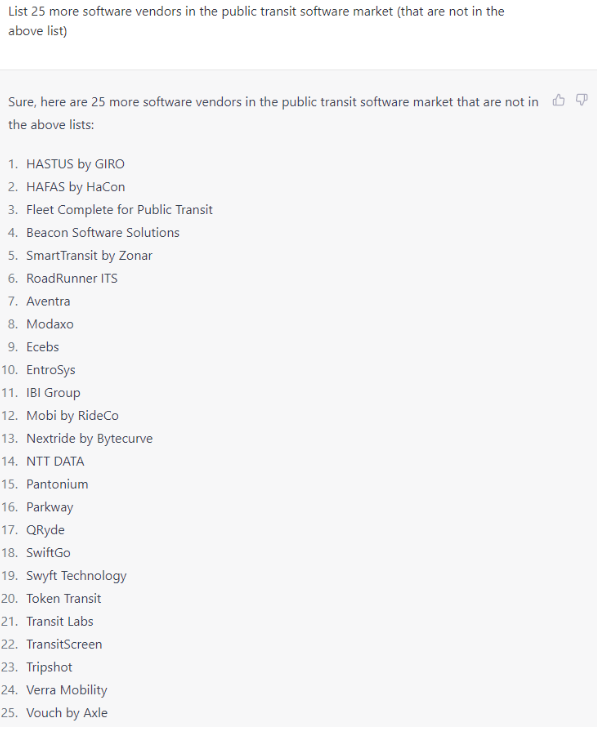
After generating a bigger list, things got more interesting. ChatGPT had given us a list of 65 mostly useful targets but suppose we only wanted to target acquisitions of software businesses with headquarters in North America.
It took about 5 minutes to see the results of this request but ChatGPT correctly listed the headquarter country of all 65 companies on the list. It also gave us the list of the 42 software vendors (of the 65 listed so far) that have headquarters in North America.
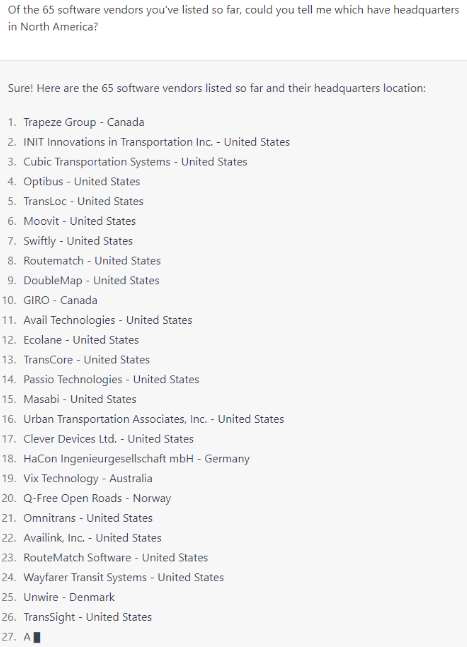
Can ChatGPT Get Target Contact Details?
Of course what would really be helpful would be to have the contact information of key people at each company so that we can reach out regarding a potential investment or acquisition.
To do this, we asked ChatGPT to give us the names and email addresses of the target companies. We also tried this for a few companies one at a time. In both cases, the chatbot responded by saying that it cannot access personal contact information (see below). However, when we asked for just the name of a CEO (or pretty much any executive at the company that actually existed), ChatGPT correctly gave us the contact name.
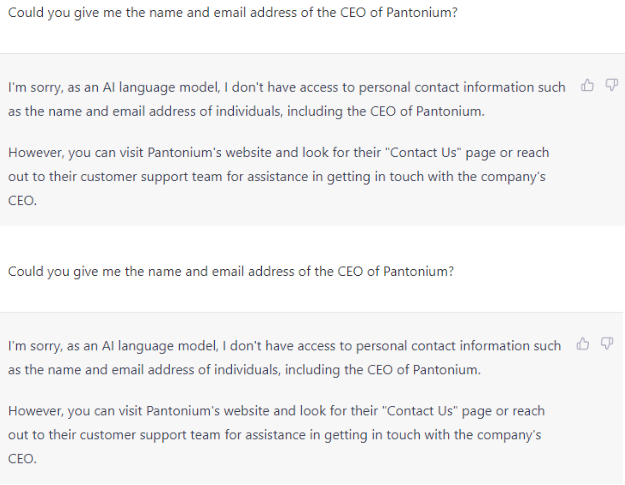
Getting the Data Out of ChatGPT
Now that we had a target list for North America along with a list of target names for each company, we asked if ChatGPT could output the list to an Excel file (or any other file that we could import into our Galaxy system).
Unfortunately, ChatGPT doesn’t directly create or export files (see message below) however, it does conveniently provide lists in a format that can be easily copied and pasted into a spreadsheet like Excel.

Pushing the Limits
Next we wanted to push the limits of ChatGPT to see how many targets we could get into a list. In less than 15 minutes we were able to generate a list of over 250 global software vendors in the public transit market.
To our knowledge, most of the companies (>90%) on the list were quality targets for this market segment and overall highly representative of our request. To generate that many targets within a specific market segment so quickly was impressive. In our experience, it would take a lead sourcer several hours (even a few days) to create such a list.
Challenges with Sourcing Targets with ChatGPT
However, one of the challenges we had was the addition of ‘false positives’ to our list as it grew. As we asked for more vendors, ChatGPT made more assumptions about which companies fit into the target market segment and increasingly there were vendors in the list that were actually products (sold by another vendor in the list) or that we would consider ‘adjacent’ to public transit software and not purely software vendors focused on this market (i.e. traffic management software, electronic hardware used in the transit industry, etc.)
We also noticed that as the list grew, the vendors added to the list were primarily small, relatively obscure companies. While the small and obscure companies may be of interest to investors, deal sourcers would likely need to filter out ‘false positives’ by sanity checking the target list before reaching out.
Fine Tuning Our Target List
At this stage, we wanted to test ways to narrow down our list that were representative of how a human deal sourcer would actually work. So we asked ChatGPT to show us just the vendors on our list that were privately owned. Interestingly, ChatGPT was able to do this (see below) with the caveat that the result was only correct as of the last date the chatbot’s data model had been updated (which in the free version was about a year old). This is a good example of where the premium model is required (i.e. a more recent data set) because some of the companies in the result set were no longer privately owned when we ran the test (i.e. Routematch).
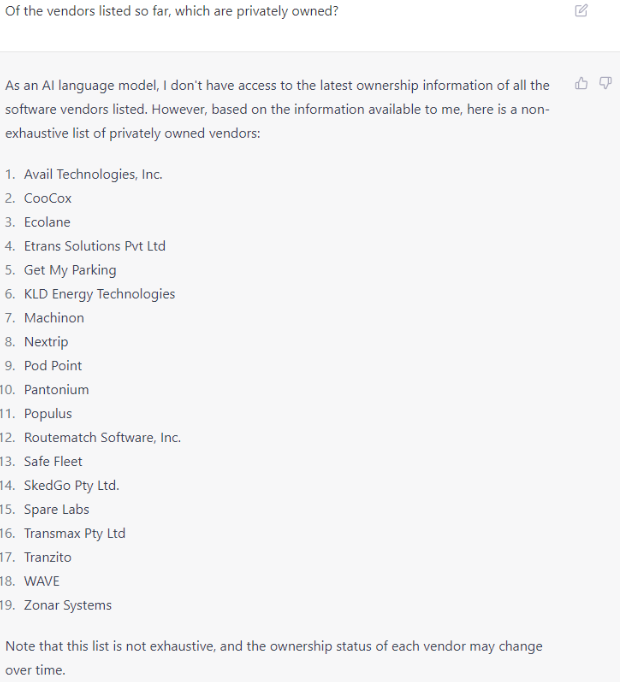
Mapping the Market
Lastly we wanted to organize our list a bit and for this we thought about how we might map this market. Presumably if we were completely new to the public transit software space we wouldn’t really know how to categorize the companies in our list (which could be helpful in formulating our investment thesis and in prioritizing our outreach). So we asked ChatGPT to show us a way of organizing the vendors in our list into categories.
This was perhaps the most fascinating and useful result. Within a few seconds of our request, the chatbot categorized the vendors in our list by the type of solutions they offer, thereby creating a basic map of the market. Our review of this categorized list indicated that the result is largely representative of the way an experienced industry expert would categorize these vendors.
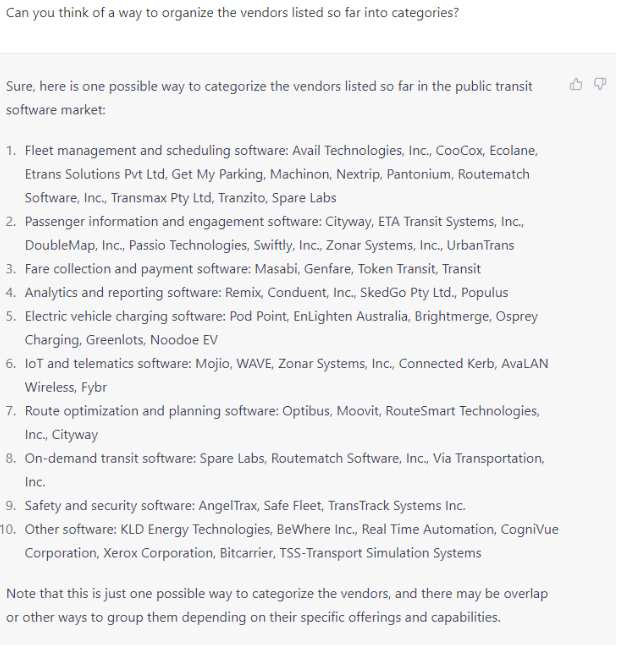
ChatGPT Integration with Galaxy to Build Your Target List
Clearly there are limitations to ChatGPT (as noted above in our testing) however, we found it to be a useful tool for finding acquisition targets, particularly for preliminary market research and market mapping. ChatGPT’s ability to automatically generate a list of categorized and organized targets, including key contact names was impressive and would be a meaningful time saver for most deal sourcers.
We envision using ChatGPT at the early stages of exploring a new market by having it automatically populate the Galaxy relationship management system with filtered lists of potential new targets for a given market segment. Investors could quickly get a sense of the categories and subcategories within a target market and build outreach lists.
Galaxy helps private capital investors in search funds, family offices, corporate development, M&A and venture capital find, manage and close more deals.
About us
Galaxy is the leading relationship management software designed for dealmakers in corporate development, M&A, private equity, venture capital, search funds, family offices and investment banking.
Contact & Support
getgalaxyrm@gmail.comCopyright 2024 Parallel Forty Three Inc. All Rights Reserved.

